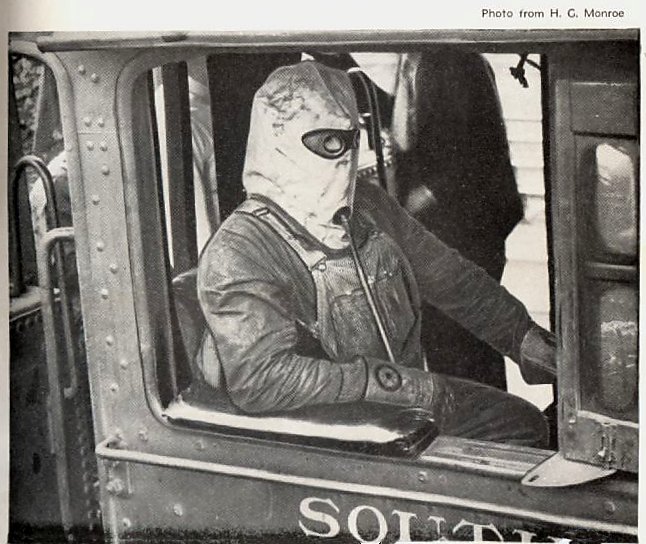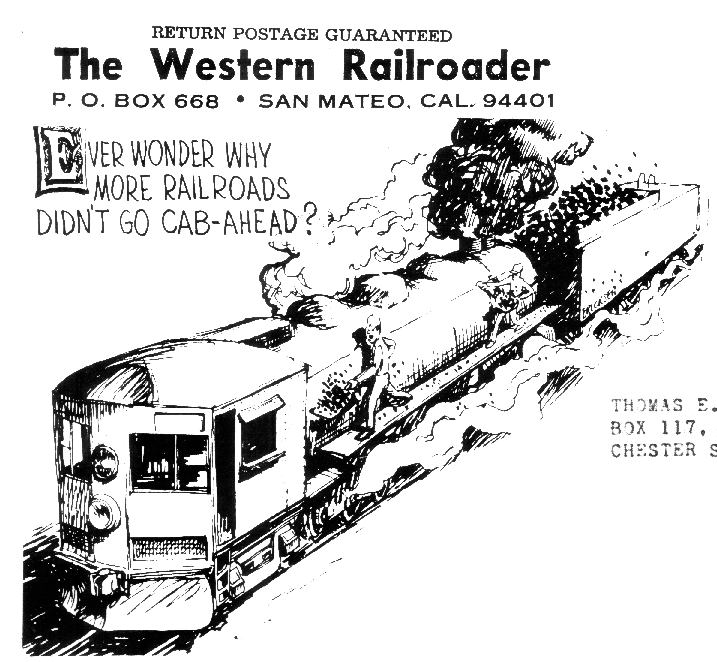Updated: 17 Dec 2014
WR pic added




The SP 4-8-8-2 Cabforward Locomotives |
Updated: 17 Dec 2014
|

The Southern Pacific railroad, in the USA, ran steam trains over demanding routes in the Sierra Nevada. Between Truckee and Blue Canyon there were 38 miles of snowsheds and tunnels, built to protect the line against snowdrifts that could be 200 feet deep in the valleys.
 | In a snowshed under that lot, you might as well be in a tunnel; in fact a tunnel might well be better ventilated because of the intermediate construction shafts along it. In such a snowshed atmospheric conditions for train crews became intolerable; presumably carbon monoxide was the main danger. To give you a feeling for how bad it was, note the picture of the Southern Pacific driver. The tube looks too narrow to breath through, so presumably it fed oxygen to the driver from a cylinder or a generator. Such oxygen systems were used in WW1 flying, so it seems plausible here. |
One answer to the problem is to run locomotives backwards (or cabforward) so that the chimney is at the rear of the engine. This also gives the driver a far better view ahead than by squinting down the side of an enormous boiler, and one might wonder why this strategy was not adopted from the start of steam railways. The answer is - fuel. It is not practicable to run the tender in front of the loco- it must be behind to avoid derailment and worse- so there were intractable difficulties in getting the coal forward to the footplate and firebox.
This problem is solved in this magnificent machine by the use of oil fuel, piped the length of the engine at five pounds pressure from the tender tank.

Above is a picture of AC4- one of the earliest of the cabforwards, delivered in 1910 ??. The first order was for 15 engines and these were all compound. At its peak the Southern Pacific had over 200 of thes locos, but all were single expansion. As usual, compunding appears not to have been worth the bother, and conversions of the older engines to simple expansion started in 1927 ?? (These dates being checked)
One of these machines (4294) is preserved in the Sacramento Railway Museum in California, and I have seen it for myself. To those of us used to the smaller British loading gauge, the sheer size of the thing is breathtaking.

VITAL STATISTICS.
Contrasting the parameters of the AC1 (the first one delivered) and the AC4 shown above.
| Built by | Baldwin | Baldwin |
| Cylinder diam | 22 in | 24 in |
| Cylinder stroke | 30 in | 32 in |
| Boiler pressure | 210 lb/sqin | 235 lb/sqin |
| Tractive Effort | 90,940 lbs | 116,900 lbs |
| Engine Weight | 481,200 lb. | 614,000 lb |
| Fuel oil carried | 3,817 gal | 4,889 gal |
| Water carried | 12,000 gal | 16,152 gal |
| Driving wheel diam | 57 in | 63 in |
A report on a fatal accident involving an SP4882.
An excellent source on Cabforwards.
Cabforwards on Wikipedia.
 | This cartoon neatly underlines the difficulty of using coal as the fuel on cab-forward locomotives. The locomotive looks to be based on the SP 4-8-8-2.It is taken from overprinted envelopes used by the The Western Railroader, which is/was a railfan magazine that began publication in 1938. Its current status is unclear (it may have closed down in 2011) but you can find some information here and by suitable Googling. |

  
|